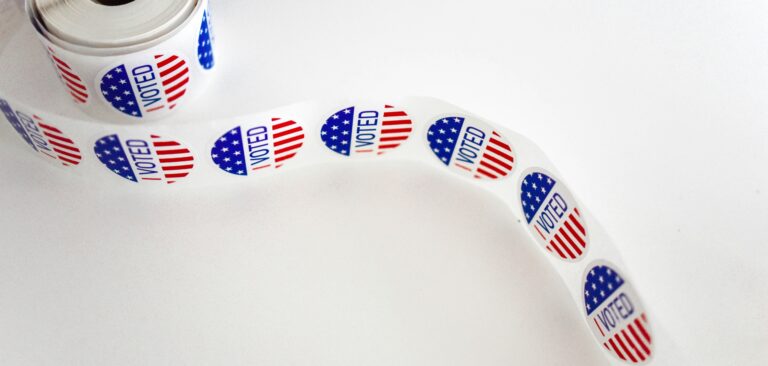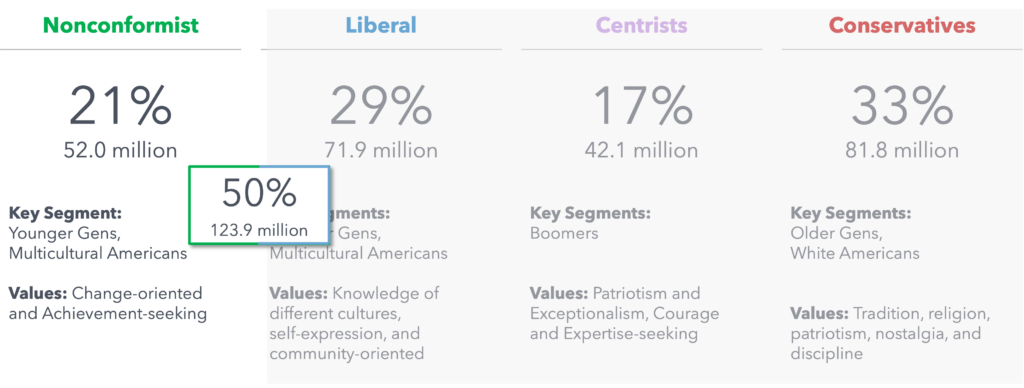Political Polarization and the Influence of Non-Conformists

As we enter 2025, with a transition of power, the level of political polarization across the nation is at an all-time high. Political affiliation is now a cultural identity and polarization is seeping into every aspect of American culture, including consumer behavior and brand engagement. Learn more about our findings on how to effectively engage sociopolitical issues.
Consumers increasingly seek brands that actively participate in issues-based marketing, demonstrating a clear alignment with their values and beliefs. And politics plays a significant role in shaping these values. According to our America Now research, a striking 48% of Americans aged 21 and above see their political beliefs as integral to who they are.
This means politics isn’t just about policies – politics is culture.
Understanding the cultural traits of four distinct political factions offers a fresh lens to navigate political polarization, with a new perspective that considers the sway of nonconformists.
In this article, we will explore these insights derived from the America Now survey. The aim is to unpack the prevailing political polarization sweeping across diverse America.
In this article we are providing non-members with a small sample of the deep cultural intelligence that fuels growth for our members. Contact us to learn how you can unlock the full version of these insights, and much more, through our always-on application, deep cultural research and custom solutions.
What Is Political Polarization?
Political polarization represents the widening gap between opposing political ideologies, characterized by growing rigidity in beliefs and partisan loyalties.
While some level of divergence in political ideas and policy objectives is expected in a thriving democracy, the scale of this division has surged since the turn of the millennium.
Back in 1994, the Pew Research Center highlighted a startling observation: the number of people holding negative perceptions toward the opposing political party had doubled. Fast forward to 2022, and those with intensely unfavorable views of the opposition have hit record highs.
“Political polarization occurs when subsets of a population adopt increasingly dissimilar attitudes toward parties and party members (i.e., affective polarization), as well as ideologies and policies (ideological polarization). With little polarization, most people support a mixture of liberal and conservative stances across issues, and they can support one party without disliking others. With very high polarization, large, separate clusters of the population endorse ideologically consistent stances across all issues and love their party while loathing the other(s).” – Gordon Hetzel and Kristin Laurin, Polarization in America: Two Possible Futures
As more Americans find themselves at opposite ends of the political spectrum, the space for moderate, centrist viewpoints is diminishing. Republicans veer to the right, while Democrats move leftward, resulting in a dwindling overlap of ideologies between the two parties.
Among the divisive topics driving this polarization, tackling climate change stands out. Only 21% of Republicans support climate action, compared to a resounding 78% of Democrats.
Other hot-button issues include:
- Safeguarding the environment,
- Reshaping gun policies,
- Fortifying the nation’s military.
Our recent survey, America Now, explores these evolving trends further to reveal unique insights that offer a new perspective on this polarization. One key finding is that distinct political ideology groups (rather than party affiliation) embody a unique cultural identity.
That is, Collage Group’s research reveals that 48% of Americans aged 21 and above now consider their political views as a significant aspect of their identity.
As a brand, understanding the nuanced characteristics of each political group is essential to forge genuine connections across diverse segments of the population.
Exploring Political Polarization as a Cultural Schism
Our America Now research has grouped consumers according to their political stance into four key segments. Three of these are presented below, ordered by group size. The fourth segment will be introduced later in this article.
Conservatives: 33% (81.8 million Americans)
- Key segments: Mostly Baby Boomers and White Americans.
- Values: Tradition, religion, patriotism, nostalgia, and discipline.
Liberals: 29% (71.9 million Americans)
- Key segments: Younger generations (mostly Millennials and Generation Z).
- Values: Knowledge of different cultures, self-expression, and community-oriented.
Centrists: 17% (42.1 million Americans)
- Key segments: Mostly Baby Boomers.
- Values: Patriotism, exceptionalism, courage, and expertise-seeking.
Next, we identified cultural groups according to the above political classification. That is, each political faction embodies its own unique culture, as is explained below.
Liberals Are the Most Diverse in Terms of Age, Race, and Ethnicity
At the heart of liberal consumer culture is the group’s cosmopolitan flair, with other values such as cultural awareness, self-expression, and active community engagement also being expressed. This uniqueness truly shines through in this segment.
Plus, the Liberal group stands as the epitome of diversity, reflecting a mosaic of backgrounds and perspectives. While White consumers make up 55% of this group, it’s important to note that they’re the largest demographic in the country. Therefore, you want to pay attention to the percentage of Hispanic, Black, and Asian representation.
Moreover, this cohort skews younger, with a notable 22% of Generation Z and 32% of Millennials identifying as liberal.
Conservatives Are Mostly White Baby Boomers With Traits Greatly Differentiated From Those of Other Americans
Conservatives stand out with distinct traits that set them apart from other political segments. They fully embrace themes of Americana in their cultural attributes. Traits such as patriotism, religiousness, perseverance, and discipline are prominently featured among the top 10, showcasing this group’s strong connection to traditional American values.
Plus, this political faction is primarily composed of older, White Americans, particularly Baby Boomers, representing 37% of the group. Plus, there’s also an absence of multicultural representation, with a skew of 70% toward White Americans.
Centrists Share Patriotic Traits With Conservatives but Differ in Their Focus on Courage
Centrists often lean toward conservative qualities, showcasing traits like patriotism, discipline, and heritage.
When it comes to generational diversity and ethnicity, Centrists find themselves in the middle ground, showing a balanced distribution across generations and some representation from diverse consumer groups.
The Forgotten Segment: Americans Who Opt out of Political Affiliation Do So Intentionally and Based on Their Unique Values
The fourth political group is often overlooked. This group doesn’t make a lot of noise and defies categorization without a defined political view. These are the nonconformists, the free spirits of the political spectrum.
Nonconformists exude a sense of introspection and reservation, yet beneath the surface, they harbor a selfless spirit and a thirst for change. This mirrors the progressive ideals and social consciousness associated with liberals.
When delving into the traits of nonconformists, it’s apparent that social anxiety and reservedness take precedence. As such, this segment tends to shy away from commenting on social media and similar platforms.
Yet, despite their reserved nature, nonconformists lean towards liberal values, forging a connection with the broader liberal cohort.
Nonconformists are a diverse group, boasting 19% Hispanic, 16% Black, and 7% Asian representation. Yet, what truly stands out is the youthfulness of this segment, with 33% belonging to Generation Z and 31% to Millennials, making it the youngest group among all segments.
Recognizing the Impact of Nonconformists in the Discussion of Political Polarization
The nonconformist segment represents 21% of the U.S. population, comprising 52 million individuals.
- Key Segments: Younger Generation Z and Millennials, and multicultural consumers.
- Values: Change-oriented and achievement-seeking.
Accounting for the nonconformists reveals a harmonious blend of values, perspectives, and culture. That is, 50% of the U.S. population leans toward liberal views. Once more, these two political groups – nonconformists and liberals – represent a culture shaped by a younger demographic. This accentuates a distinct political polarization that spans generations.

This article includes a small sample of the deep cultural intelligence in our flagship America Now report that fuels growth for our members. Contact us to learn how you can unlock the full version of these insights, and much more, through our always-on application, deep cultural research and custom solutions.